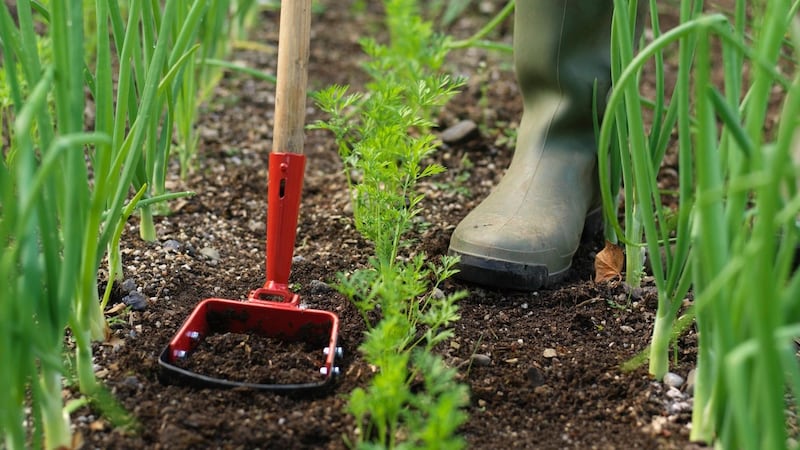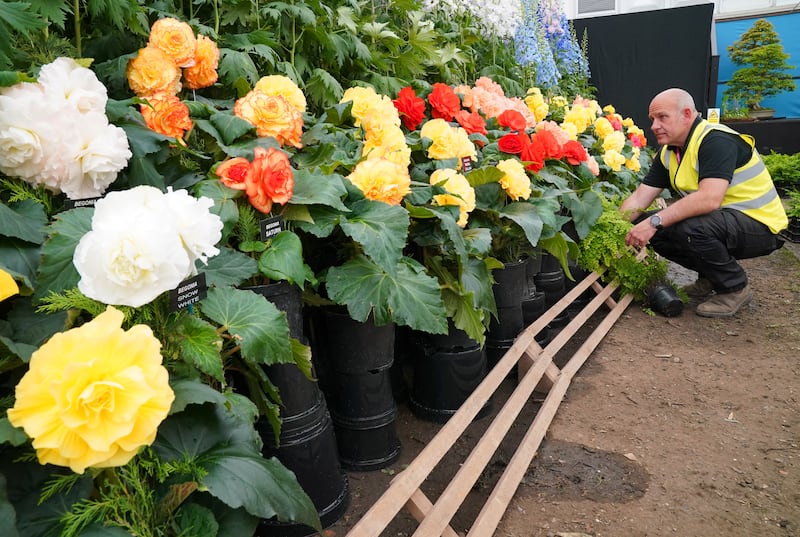As someone who shivers at the thought of a chilly breeze, I’m well and truly done with our long, wet, cold spring. So much so, that I find myself daydreaming of brilliant sunshine, blue skies and warm breezes.
Some of our favourite species of summer garden plants feel exactly the same. Put a young tomato plant outdoors at this meteorologically variable time of the Irish growing year, without any protection from cold northerly winds or low night temperatures, and this tender, heat-loving annual vegetable (technically a fruit) is quite likely to go belly-up.
The same goes for any half-hardy or tender bedding plants put out before the end of the month, which run the risk of being damaged or even killed by a biting late spring frost or chilly gales. Examples include begonia, cosmos, true geranium, lobelia, surfinia, petunia, argyranthemum, senetti, and tagetes, trays of which can be seen shivering sadly in trolleys outside supermarkets around the country at this time of year.
Harsh as it sounds, nature similarly doesn’t care that the heat-loving tender and half-hardy annual seedlings we’ve lovingly raised indoors are now desperate to be moved outdoors. Instead it’s a case of the survival of the fittest, a brutal annual contest that sends thousands of tender and half-hardy young plants to their quick death at this time of year, so determined are we to convince ourselves that summer has finally arrived.
David Davin-Power, former RTÉ correspondent, dies aged 72
Former HSE manager shared child sexual abuse images of ‘utmost depravity’ online, Mayo court hears
Ballyfin restaurant review: ‘Downright dazzling, one of the most delicious things I’ve eaten this year’
We’re meant to bask in Saoirse Ronan’s feminist triumph, but I find it all a bit nauseating
Thankfully there are clever ways for gardeners to get around this. The most obvious is to use some sort of covered growing space to give vulnerable seedlings and baby plants some temporary protection until the end of the month when conditions typically become suitable for transplanting them outdoors. This could be a large permanent structure such as a bright porch, conservatory, glasshouse or a polytunnel in which to grow half-hardy and tender species. Just bear in mind that you’ll need to continue to provide some sort of additional protection at night, as temperatures inside these covered structures at this time of year can still sometimes drop into low single figures or worse.
Traditionally many gardeners often use a thermostatically controlled heater for this purpose, setting it to turn on when dangerously low temperatures threaten. But the combination of rising energy prices and sustainability concerns mean that many are seeking out alternatives.
One cost-effective solution is to dedicate just one section to the plants that need this extra protection, whether by virtue of their youth or the fact that they’re not reliably hardy, and then focus on keeping just this area warmer. For example, electric grow mats (stockists include fruithillfarm.com and thepolytunnelcompany.ie) placed on a board of roof insulation can be used to efficiently give targeted bottom heat to trays of seedlings and tender transplants, with a few layers of protective crop fabric suspended over the plants at night for extra protection using hoops or a rough home-made timber frame.
Another alternative is to custom-make your own dedicated grow box out of timber, lining the base and sides of this rectangular structure with rigid roof insulation for extra protection. Covered over on cold nights with another removable sheet of rigid roof insulation and a few layers of fleece, this is a brilliant and cost-effective way to keep vulnerable seedlings and young plants snug and safe.
This same home-made structure can also be adapted for use outdoors. In this case you’ll be using it as a modern, highly insulated version of the traditional cold frame, again removing the insulated lid during the day to allow light to reach the seedlings and young transplants but leaving a layer or two of Enviromesh and some horticultural fleece over the top for protection against cold winds.
Alternatively, if you have space in an unused basement or old outbuilding, you can use this sort of home-made grow box with grow lights suspended over the plants, a wonderfully effective way to grow strong, sturdy, healthy plants.
Ballymaloe Cookery School in east Cork recently created their own large-scale version of this, an insulated grow-room in a disused mushroom shed, with brilliant results. When I visited it in March, it was already brimming with seedlings of tender vegetables and herbs destined for their kitchen garden and glasshouses.

Unfortunately, as climate change disrupts Ireland’s seasonal weather patterns, gardeners are also increasingly discovering that it’s not just late spring frosts and chilling winds that are causing damage to our vulnerable seedlings and transplants. Instead, there’s a growing risk of the latter suffering a series of sudden fierce checks to their growth in summer after cold buffeting winds, hail, rain and cooler-than-average temperatures.
Again, like a light but warm cardigan on a cool summer afternoon, crop protection can have a near-miraculous effect in this situation in terms of boosting growth levels, preventing damage to foliage, flowers and fruit, and keeping leafy food crops tender and flavoursome. A loose layer or two of Enviromesh, Climate Net or Bionet, for example, placed over salad crops and secured at its edges with boards, sandbags, or a ribbon of soil can work wonders (see fruithillfarm.com). The same goes for a line of freshly-planted baby sweet pea, a young hedge, or a newly-filled pot of summer bedding that you’d like to temporarily protect until the plants are better established and more able to cope with the vagaries of the Irish weather.
Other similarly useful forms of plant protection include portable mini grow-tunnels and raised bed covers that can be custom-made to fit the space (see quickcrop.ie and polytunnelcompany.ie). I’ve also seen impressively effective plant protection created on a tight budget, using sheets of clear plastic polycarbonate securely fixed to sturdy recycled scaffold supports to create the equivalent of an open-sided polytunnel. Safe from the worst of summer downpours and sudden violent gales, lines of heat-loving dahlias thrived beneath its protective cover.
It’s worth adding that all of the above forms of protection can also help to shield plants from the damage caused by common pests such as carrot fly, cabbage root fly, cabbage white butterfly, pigeons, rabbits and deer, as well as help shield the soil from erosion while simultaneously allowing light to reach them. In short, these modern materials and techniques make it much easier for us to garden well in a world where that is becoming increasingly challenging.
This week in the garden

It’s still too early to plant out half hardy and tender plants, unless you can offer them some form of protection against cold temperatures. But this is a great time to get beds prepped and ready for planting. Hoe away any weeds, making sure to dig out the root systems of stubborn perennials such as buttercup, dandelion, dock and scutch, then add a light covering layer of home-made garden compost, before temporarily covering the ground with a sheet of strong black plastic to prevent fresh weed growth and help warm it up in advance of planting.
Dates for your diary

Tuesday, May 21st, to Saturday, May 25th, RHS Chelsea Flower Show. See rhs.org.uk
Saturday, May 25th, 11am-5pm, Teak House, National Botanic Gardens, Glasnevin, Dublin 9, Irish Cactus and Succulent Society Show, with plant displays, plant sales and demonstrations.
- Sign up for push alerts and have the best news, analysis and comment delivered directly to your phone
- Find The Irish Times on WhatsApp and stay up to date
- Listen to our Inside Politics podcast for the best political chat and analysis





